Corporate Failures in Australia: Role of Liabilities and Corporate Governance
VerifiedAdded on 2023/06/04
|8
|2703
|454
AI Summary
This report analyses the bankruptcies of three companies in Australia and critically analyses the role played by liabilities with regards to these corporate failures. It also highlights the importance of corporate governance and ethics training to avoid such incidents in the future.
Contribute Materials
Your contribution can guide someone’s learning journey. Share your
documents today.
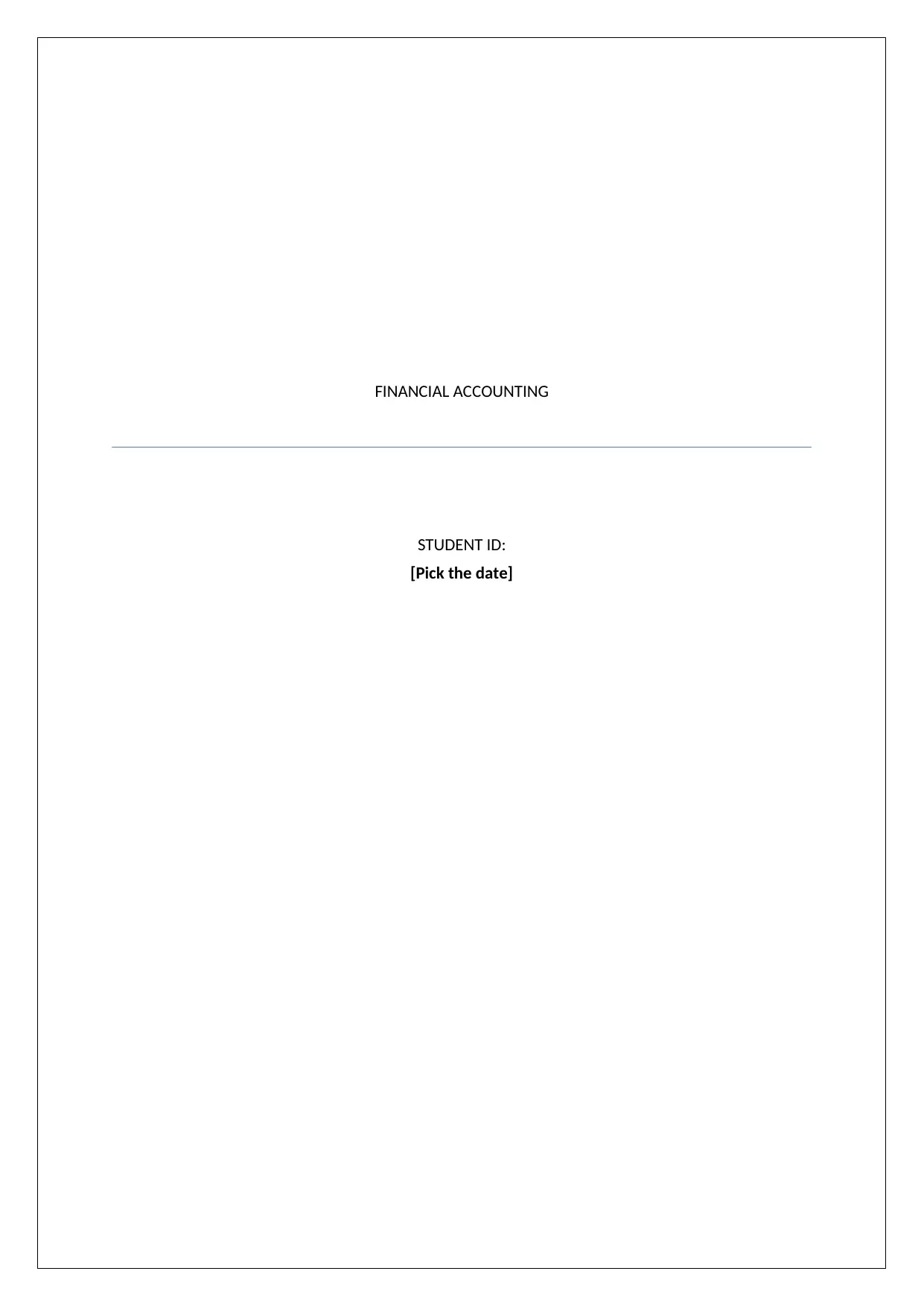
FINANCIAL ACCOUNTING
STUDENT ID:
[Pick the date]
STUDENT ID:
[Pick the date]
Secure Best Marks with AI Grader
Need help grading? Try our AI Grader for instant feedback on your assignments.
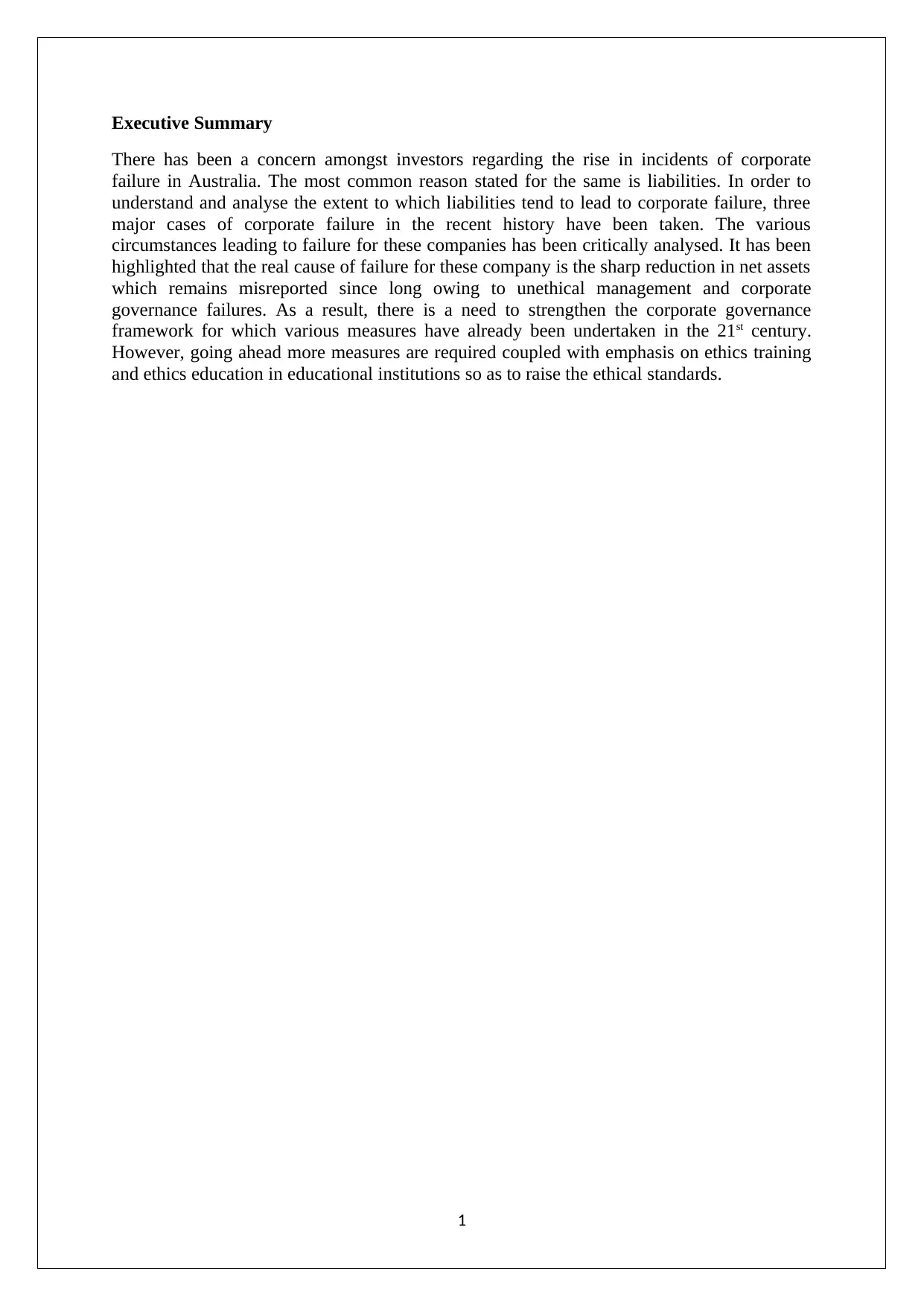
Executive Summary
There has been a concern amongst investors regarding the rise in incidents of corporate
failure in Australia. The most common reason stated for the same is liabilities. In order to
understand and analyse the extent to which liabilities tend to lead to corporate failure, three
major cases of corporate failure in the recent history have been taken. The various
circumstances leading to failure for these companies has been critically analysed. It has been
highlighted that the real cause of failure for these company is the sharp reduction in net assets
which remains misreported since long owing to unethical management and corporate
governance failures. As a result, there is a need to strengthen the corporate governance
framework for which various measures have already been undertaken in the 21st century.
However, going ahead more measures are required coupled with emphasis on ethics training
and ethics education in educational institutions so as to raise the ethical standards.
1
There has been a concern amongst investors regarding the rise in incidents of corporate
failure in Australia. The most common reason stated for the same is liabilities. In order to
understand and analyse the extent to which liabilities tend to lead to corporate failure, three
major cases of corporate failure in the recent history have been taken. The various
circumstances leading to failure for these companies has been critically analysed. It has been
highlighted that the real cause of failure for these company is the sharp reduction in net assets
which remains misreported since long owing to unethical management and corporate
governance failures. As a result, there is a need to strengthen the corporate governance
framework for which various measures have already been undertaken in the 21st century.
However, going ahead more measures are required coupled with emphasis on ethics training
and ethics education in educational institutions so as to raise the ethical standards.
1
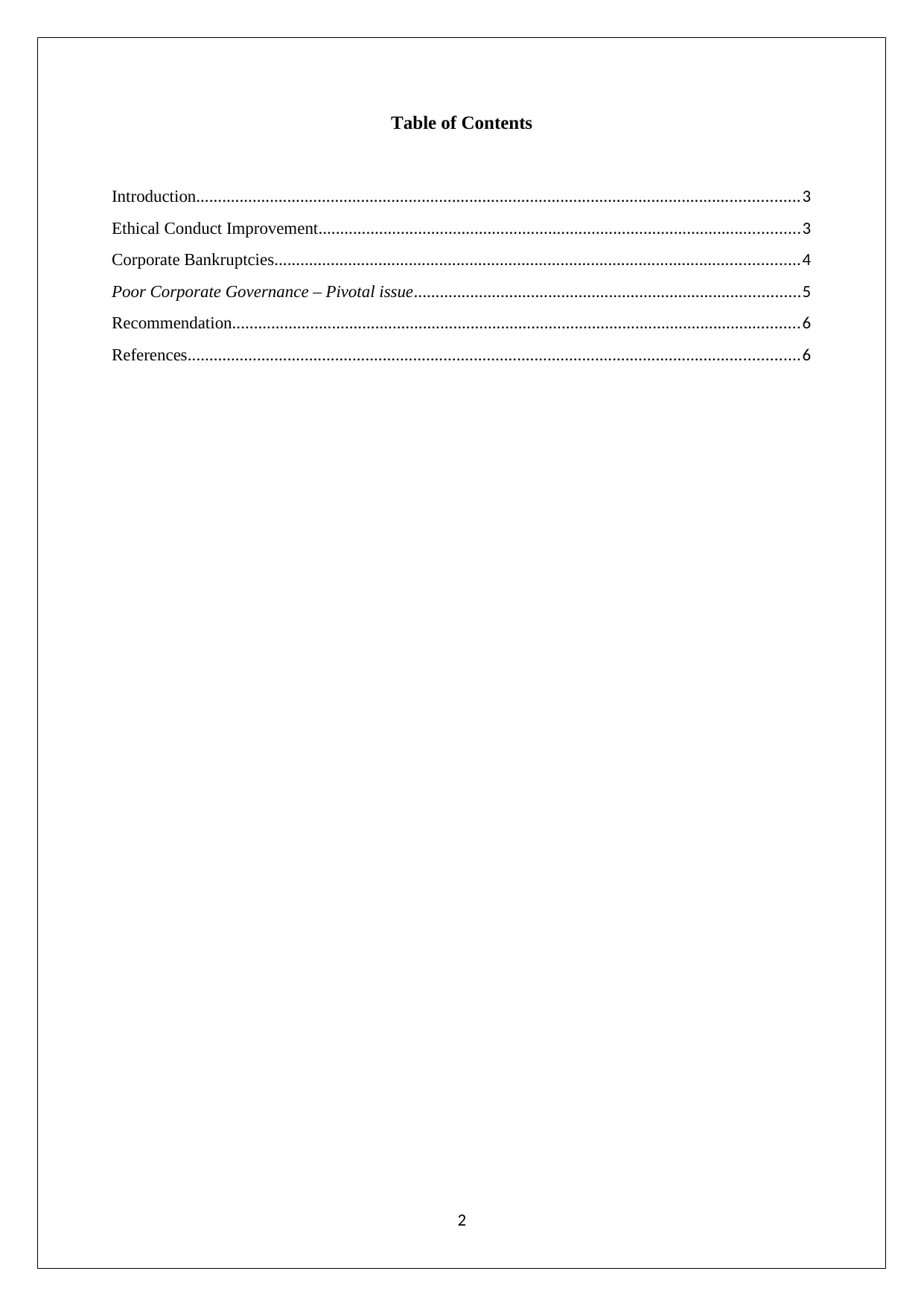
Table of Contents
Introduction...........................................................................................................................................3
Ethical Conduct Improvement...............................................................................................................3
Corporate Bankruptcies.........................................................................................................................4
Poor Corporate Governance – Pivotal issue.........................................................................................5
Recommendation...................................................................................................................................6
References.............................................................................................................................................6
2
Introduction...........................................................................................................................................3
Ethical Conduct Improvement...............................................................................................................3
Corporate Bankruptcies.........................................................................................................................4
Poor Corporate Governance – Pivotal issue.........................................................................................5
Recommendation...................................................................................................................................6
References.............................................................................................................................................6
2
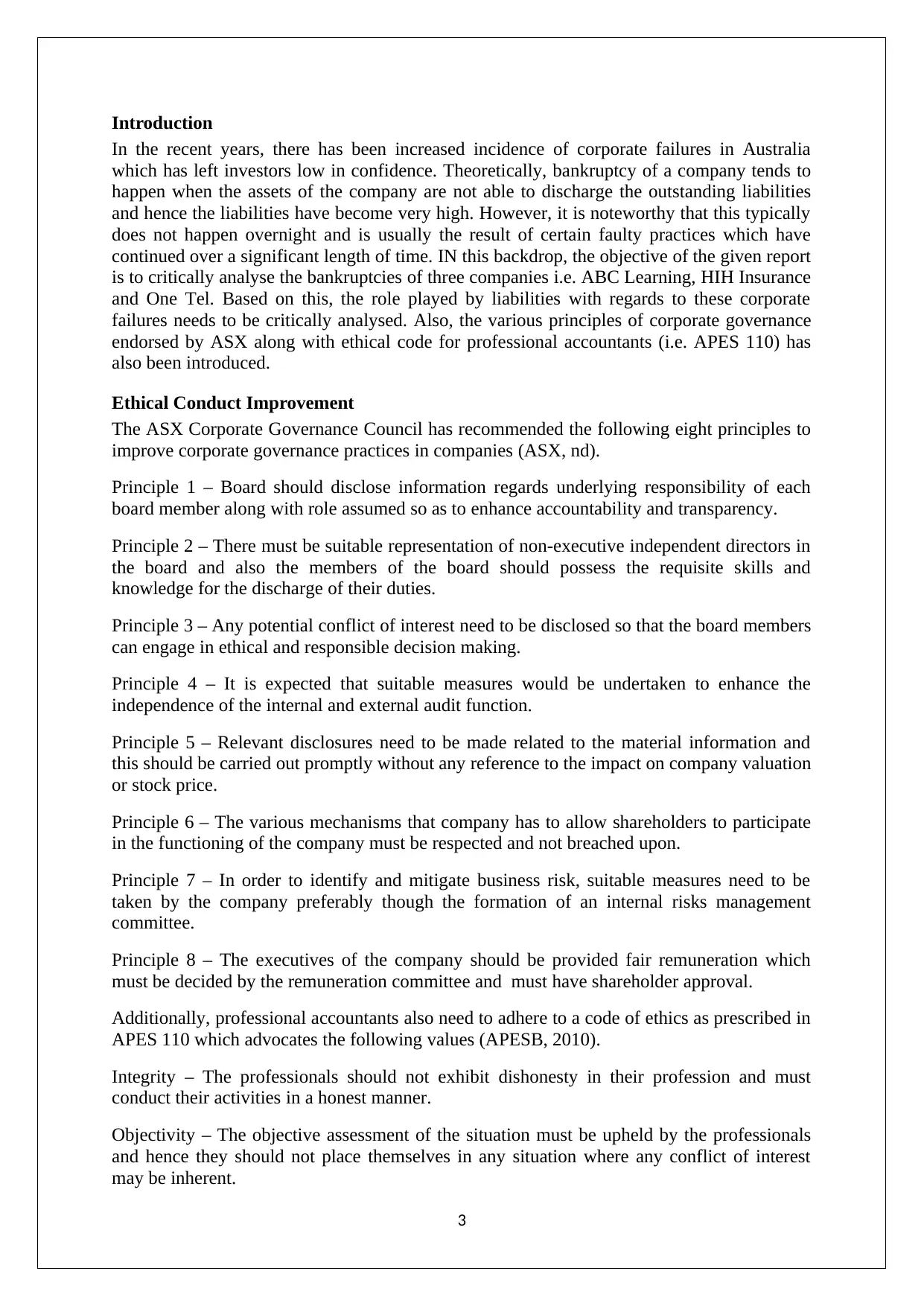
Introduction
In the recent years, there has been increased incidence of corporate failures in Australia
which has left investors low in confidence. Theoretically, bankruptcy of a company tends to
happen when the assets of the company are not able to discharge the outstanding liabilities
and hence the liabilities have become very high. However, it is noteworthy that this typically
does not happen overnight and is usually the result of certain faulty practices which have
continued over a significant length of time. IN this backdrop, the objective of the given report
is to critically analyse the bankruptcies of three companies i.e. ABC Learning, HIH Insurance
and One Tel. Based on this, the role played by liabilities with regards to these corporate
failures needs to be critically analysed. Also, the various principles of corporate governance
endorsed by ASX along with ethical code for professional accountants (i.e. APES 110) has
also been introduced.
Ethical Conduct Improvement
The ASX Corporate Governance Council has recommended the following eight principles to
improve corporate governance practices in companies (ASX, nd).
Principle 1 – Board should disclose information regards underlying responsibility of each
board member along with role assumed so as to enhance accountability and transparency.
Principle 2 – There must be suitable representation of non-executive independent directors in
the board and also the members of the board should possess the requisite skills and
knowledge for the discharge of their duties.
Principle 3 – Any potential conflict of interest need to be disclosed so that the board members
can engage in ethical and responsible decision making.
Principle 4 – It is expected that suitable measures would be undertaken to enhance the
independence of the internal and external audit function.
Principle 5 – Relevant disclosures need to be made related to the material information and
this should be carried out promptly without any reference to the impact on company valuation
or stock price.
Principle 6 – The various mechanisms that company has to allow shareholders to participate
in the functioning of the company must be respected and not breached upon.
Principle 7 – In order to identify and mitigate business risk, suitable measures need to be
taken by the company preferably though the formation of an internal risks management
committee.
Principle 8 – The executives of the company should be provided fair remuneration which
must be decided by the remuneration committee and must have shareholder approval.
Additionally, professional accountants also need to adhere to a code of ethics as prescribed in
APES 110 which advocates the following values (APESB, 2010).
Integrity – The professionals should not exhibit dishonesty in their profession and must
conduct their activities in a honest manner.
Objectivity – The objective assessment of the situation must be upheld by the professionals
and hence they should not place themselves in any situation where any conflict of interest
may be inherent.
3
In the recent years, there has been increased incidence of corporate failures in Australia
which has left investors low in confidence. Theoretically, bankruptcy of a company tends to
happen when the assets of the company are not able to discharge the outstanding liabilities
and hence the liabilities have become very high. However, it is noteworthy that this typically
does not happen overnight and is usually the result of certain faulty practices which have
continued over a significant length of time. IN this backdrop, the objective of the given report
is to critically analyse the bankruptcies of three companies i.e. ABC Learning, HIH Insurance
and One Tel. Based on this, the role played by liabilities with regards to these corporate
failures needs to be critically analysed. Also, the various principles of corporate governance
endorsed by ASX along with ethical code for professional accountants (i.e. APES 110) has
also been introduced.
Ethical Conduct Improvement
The ASX Corporate Governance Council has recommended the following eight principles to
improve corporate governance practices in companies (ASX, nd).
Principle 1 – Board should disclose information regards underlying responsibility of each
board member along with role assumed so as to enhance accountability and transparency.
Principle 2 – There must be suitable representation of non-executive independent directors in
the board and also the members of the board should possess the requisite skills and
knowledge for the discharge of their duties.
Principle 3 – Any potential conflict of interest need to be disclosed so that the board members
can engage in ethical and responsible decision making.
Principle 4 – It is expected that suitable measures would be undertaken to enhance the
independence of the internal and external audit function.
Principle 5 – Relevant disclosures need to be made related to the material information and
this should be carried out promptly without any reference to the impact on company valuation
or stock price.
Principle 6 – The various mechanisms that company has to allow shareholders to participate
in the functioning of the company must be respected and not breached upon.
Principle 7 – In order to identify and mitigate business risk, suitable measures need to be
taken by the company preferably though the formation of an internal risks management
committee.
Principle 8 – The executives of the company should be provided fair remuneration which
must be decided by the remuneration committee and must have shareholder approval.
Additionally, professional accountants also need to adhere to a code of ethics as prescribed in
APES 110 which advocates the following values (APESB, 2010).
Integrity – The professionals should not exhibit dishonesty in their profession and must
conduct their activities in a honest manner.
Objectivity – The objective assessment of the situation must be upheld by the professionals
and hence they should not place themselves in any situation where any conflict of interest
may be inherent.
3
Secure Best Marks with AI Grader
Need help grading? Try our AI Grader for instant feedback on your assignments.
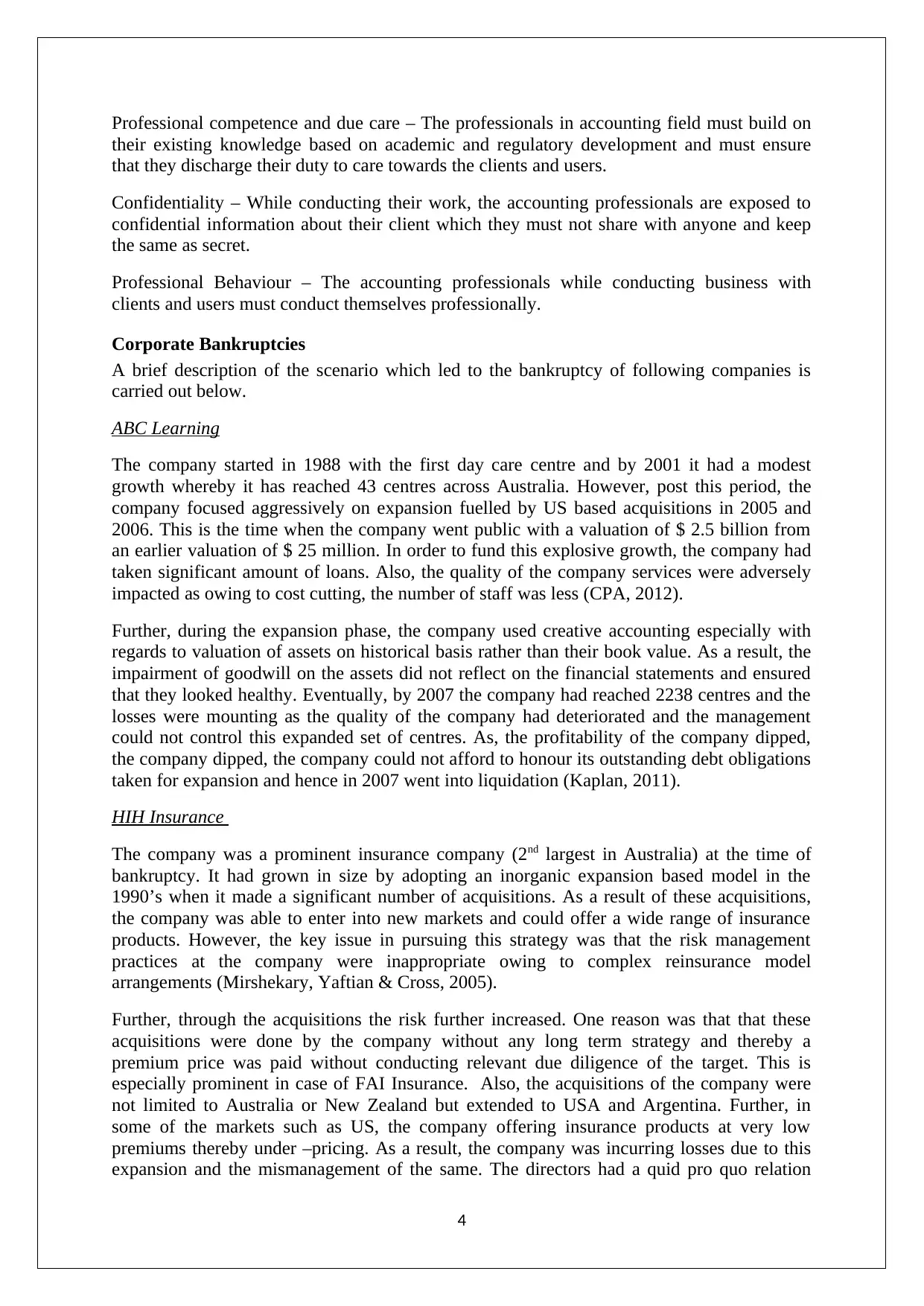
Professional competence and due care – The professionals in accounting field must build on
their existing knowledge based on academic and regulatory development and must ensure
that they discharge their duty to care towards the clients and users.
Confidentiality – While conducting their work, the accounting professionals are exposed to
confidential information about their client which they must not share with anyone and keep
the same as secret.
Professional Behaviour – The accounting professionals while conducting business with
clients and users must conduct themselves professionally.
Corporate Bankruptcies
A brief description of the scenario which led to the bankruptcy of following companies is
carried out below.
ABC Learning
The company started in 1988 with the first day care centre and by 2001 it had a modest
growth whereby it has reached 43 centres across Australia. However, post this period, the
company focused aggressively on expansion fuelled by US based acquisitions in 2005 and
2006. This is the time when the company went public with a valuation of $ 2.5 billion from
an earlier valuation of $ 25 million. In order to fund this explosive growth, the company had
taken significant amount of loans. Also, the quality of the company services were adversely
impacted as owing to cost cutting, the number of staff was less (CPA, 2012).
Further, during the expansion phase, the company used creative accounting especially with
regards to valuation of assets on historical basis rather than their book value. As a result, the
impairment of goodwill on the assets did not reflect on the financial statements and ensured
that they looked healthy. Eventually, by 2007 the company had reached 2238 centres and the
losses were mounting as the quality of the company had deteriorated and the management
could not control this expanded set of centres. As, the profitability of the company dipped,
the company dipped, the company could not afford to honour its outstanding debt obligations
taken for expansion and hence in 2007 went into liquidation (Kaplan, 2011).
HIH Insurance
The company was a prominent insurance company (2nd largest in Australia) at the time of
bankruptcy. It had grown in size by adopting an inorganic expansion based model in the
1990’s when it made a significant number of acquisitions. As a result of these acquisitions,
the company was able to enter into new markets and could offer a wide range of insurance
products. However, the key issue in pursuing this strategy was that the risk management
practices at the company were inappropriate owing to complex reinsurance model
arrangements (Mirshekary, Yaftian & Cross, 2005).
Further, through the acquisitions the risk further increased. One reason was that that these
acquisitions were done by the company without any long term strategy and thereby a
premium price was paid without conducting relevant due diligence of the target. This is
especially prominent in case of FAI Insurance. Also, the acquisitions of the company were
not limited to Australia or New Zealand but extended to USA and Argentina. Further, in
some of the markets such as US, the company offering insurance products at very low
premiums thereby under –pricing. As a result, the company was incurring losses due to this
expansion and the mismanagement of the same. The directors had a quid pro quo relation
4
their existing knowledge based on academic and regulatory development and must ensure
that they discharge their duty to care towards the clients and users.
Confidentiality – While conducting their work, the accounting professionals are exposed to
confidential information about their client which they must not share with anyone and keep
the same as secret.
Professional Behaviour – The accounting professionals while conducting business with
clients and users must conduct themselves professionally.
Corporate Bankruptcies
A brief description of the scenario which led to the bankruptcy of following companies is
carried out below.
ABC Learning
The company started in 1988 with the first day care centre and by 2001 it had a modest
growth whereby it has reached 43 centres across Australia. However, post this period, the
company focused aggressively on expansion fuelled by US based acquisitions in 2005 and
2006. This is the time when the company went public with a valuation of $ 2.5 billion from
an earlier valuation of $ 25 million. In order to fund this explosive growth, the company had
taken significant amount of loans. Also, the quality of the company services were adversely
impacted as owing to cost cutting, the number of staff was less (CPA, 2012).
Further, during the expansion phase, the company used creative accounting especially with
regards to valuation of assets on historical basis rather than their book value. As a result, the
impairment of goodwill on the assets did not reflect on the financial statements and ensured
that they looked healthy. Eventually, by 2007 the company had reached 2238 centres and the
losses were mounting as the quality of the company had deteriorated and the management
could not control this expanded set of centres. As, the profitability of the company dipped,
the company dipped, the company could not afford to honour its outstanding debt obligations
taken for expansion and hence in 2007 went into liquidation (Kaplan, 2011).
HIH Insurance
The company was a prominent insurance company (2nd largest in Australia) at the time of
bankruptcy. It had grown in size by adopting an inorganic expansion based model in the
1990’s when it made a significant number of acquisitions. As a result of these acquisitions,
the company was able to enter into new markets and could offer a wide range of insurance
products. However, the key issue in pursuing this strategy was that the risk management
practices at the company were inappropriate owing to complex reinsurance model
arrangements (Mirshekary, Yaftian & Cross, 2005).
Further, through the acquisitions the risk further increased. One reason was that that these
acquisitions were done by the company without any long term strategy and thereby a
premium price was paid without conducting relevant due diligence of the target. This is
especially prominent in case of FAI Insurance. Also, the acquisitions of the company were
not limited to Australia or New Zealand but extended to USA and Argentina. Further, in
some of the markets such as US, the company offering insurance products at very low
premiums thereby under –pricing. As a result, the company was incurring losses due to this
expansion and the mismanagement of the same. The directors had a quid pro quo relation
4
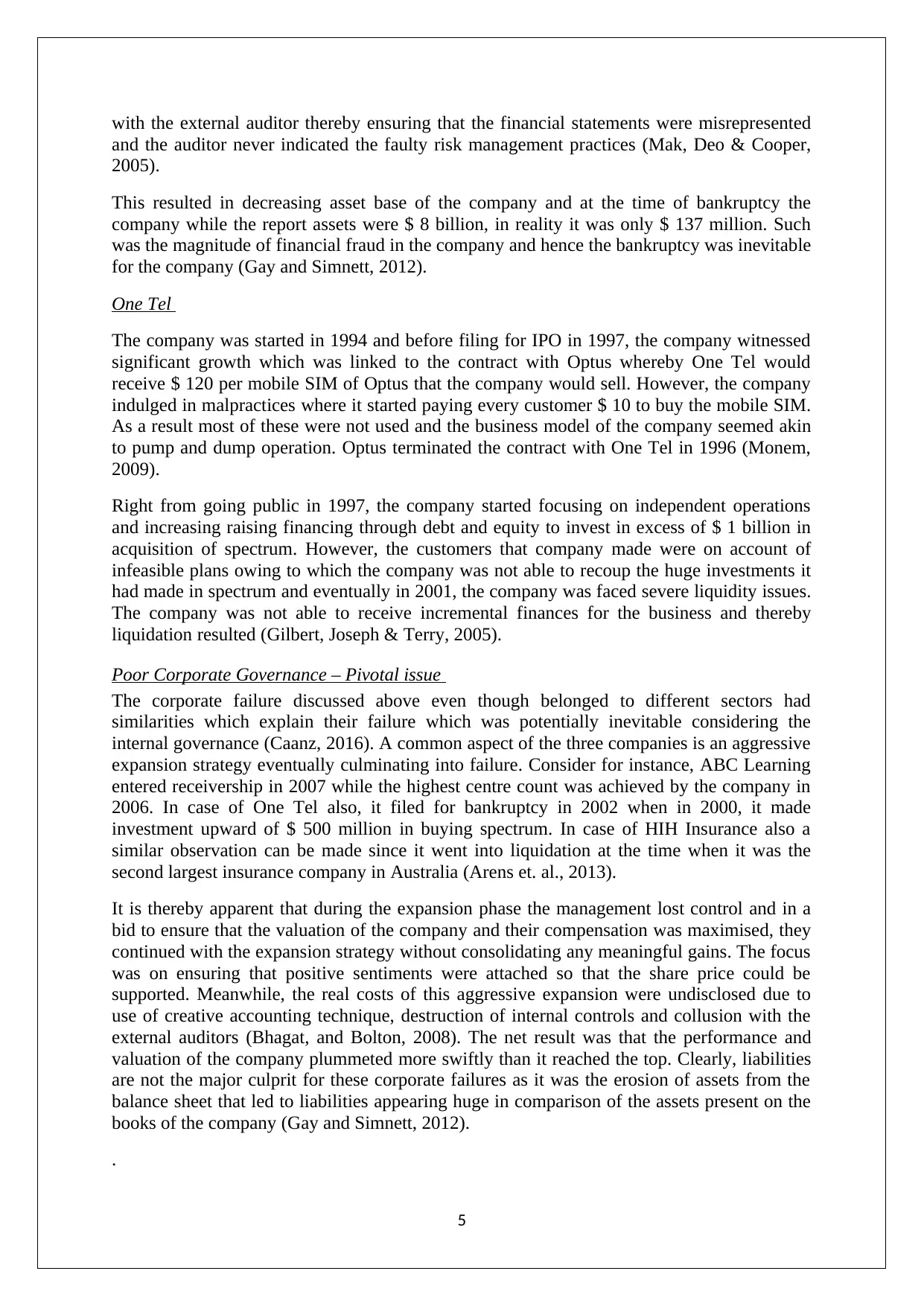
with the external auditor thereby ensuring that the financial statements were misrepresented
and the auditor never indicated the faulty risk management practices (Mak, Deo & Cooper,
2005).
This resulted in decreasing asset base of the company and at the time of bankruptcy the
company while the report assets were $ 8 billion, in reality it was only $ 137 million. Such
was the magnitude of financial fraud in the company and hence the bankruptcy was inevitable
for the company (Gay and Simnett, 2012).
One Tel
The company was started in 1994 and before filing for IPO in 1997, the company witnessed
significant growth which was linked to the contract with Optus whereby One Tel would
receive $ 120 per mobile SIM of Optus that the company would sell. However, the company
indulged in malpractices where it started paying every customer $ 10 to buy the mobile SIM.
As a result most of these were not used and the business model of the company seemed akin
to pump and dump operation. Optus terminated the contract with One Tel in 1996 (Monem,
2009).
Right from going public in 1997, the company started focusing on independent operations
and increasing raising financing through debt and equity to invest in excess of $ 1 billion in
acquisition of spectrum. However, the customers that company made were on account of
infeasible plans owing to which the company was not able to recoup the huge investments it
had made in spectrum and eventually in 2001, the company was faced severe liquidity issues.
The company was not able to receive incremental finances for the business and thereby
liquidation resulted (Gilbert, Joseph & Terry, 2005).
Poor Corporate Governance – Pivotal issue
The corporate failure discussed above even though belonged to different sectors had
similarities which explain their failure which was potentially inevitable considering the
internal governance (Caanz, 2016). A common aspect of the three companies is an aggressive
expansion strategy eventually culminating into failure. Consider for instance, ABC Learning
entered receivership in 2007 while the highest centre count was achieved by the company in
2006. In case of One Tel also, it filed for bankruptcy in 2002 when in 2000, it made
investment upward of $ 500 million in buying spectrum. In case of HIH Insurance also a
similar observation can be made since it went into liquidation at the time when it was the
second largest insurance company in Australia (Arens et. al., 2013).
It is thereby apparent that during the expansion phase the management lost control and in a
bid to ensure that the valuation of the company and their compensation was maximised, they
continued with the expansion strategy without consolidating any meaningful gains. The focus
was on ensuring that positive sentiments were attached so that the share price could be
supported. Meanwhile, the real costs of this aggressive expansion were undisclosed due to
use of creative accounting technique, destruction of internal controls and collusion with the
external auditors (Bhagat, and Bolton, 2008). The net result was that the performance and
valuation of the company plummeted more swiftly than it reached the top. Clearly, liabilities
are not the major culprit for these corporate failures as it was the erosion of assets from the
balance sheet that led to liabilities appearing huge in comparison of the assets present on the
books of the company (Gay and Simnett, 2012).
.
5
and the auditor never indicated the faulty risk management practices (Mak, Deo & Cooper,
2005).
This resulted in decreasing asset base of the company and at the time of bankruptcy the
company while the report assets were $ 8 billion, in reality it was only $ 137 million. Such
was the magnitude of financial fraud in the company and hence the bankruptcy was inevitable
for the company (Gay and Simnett, 2012).
One Tel
The company was started in 1994 and before filing for IPO in 1997, the company witnessed
significant growth which was linked to the contract with Optus whereby One Tel would
receive $ 120 per mobile SIM of Optus that the company would sell. However, the company
indulged in malpractices where it started paying every customer $ 10 to buy the mobile SIM.
As a result most of these were not used and the business model of the company seemed akin
to pump and dump operation. Optus terminated the contract with One Tel in 1996 (Monem,
2009).
Right from going public in 1997, the company started focusing on independent operations
and increasing raising financing through debt and equity to invest in excess of $ 1 billion in
acquisition of spectrum. However, the customers that company made were on account of
infeasible plans owing to which the company was not able to recoup the huge investments it
had made in spectrum and eventually in 2001, the company was faced severe liquidity issues.
The company was not able to receive incremental finances for the business and thereby
liquidation resulted (Gilbert, Joseph & Terry, 2005).
Poor Corporate Governance – Pivotal issue
The corporate failure discussed above even though belonged to different sectors had
similarities which explain their failure which was potentially inevitable considering the
internal governance (Caanz, 2016). A common aspect of the three companies is an aggressive
expansion strategy eventually culminating into failure. Consider for instance, ABC Learning
entered receivership in 2007 while the highest centre count was achieved by the company in
2006. In case of One Tel also, it filed for bankruptcy in 2002 when in 2000, it made
investment upward of $ 500 million in buying spectrum. In case of HIH Insurance also a
similar observation can be made since it went into liquidation at the time when it was the
second largest insurance company in Australia (Arens et. al., 2013).
It is thereby apparent that during the expansion phase the management lost control and in a
bid to ensure that the valuation of the company and their compensation was maximised, they
continued with the expansion strategy without consolidating any meaningful gains. The focus
was on ensuring that positive sentiments were attached so that the share price could be
supported. Meanwhile, the real costs of this aggressive expansion were undisclosed due to
use of creative accounting technique, destruction of internal controls and collusion with the
external auditors (Bhagat, and Bolton, 2008). The net result was that the performance and
valuation of the company plummeted more swiftly than it reached the top. Clearly, liabilities
are not the major culprit for these corporate failures as it was the erosion of assets from the
balance sheet that led to liabilities appearing huge in comparison of the assets present on the
books of the company (Gay and Simnett, 2012).
.
5
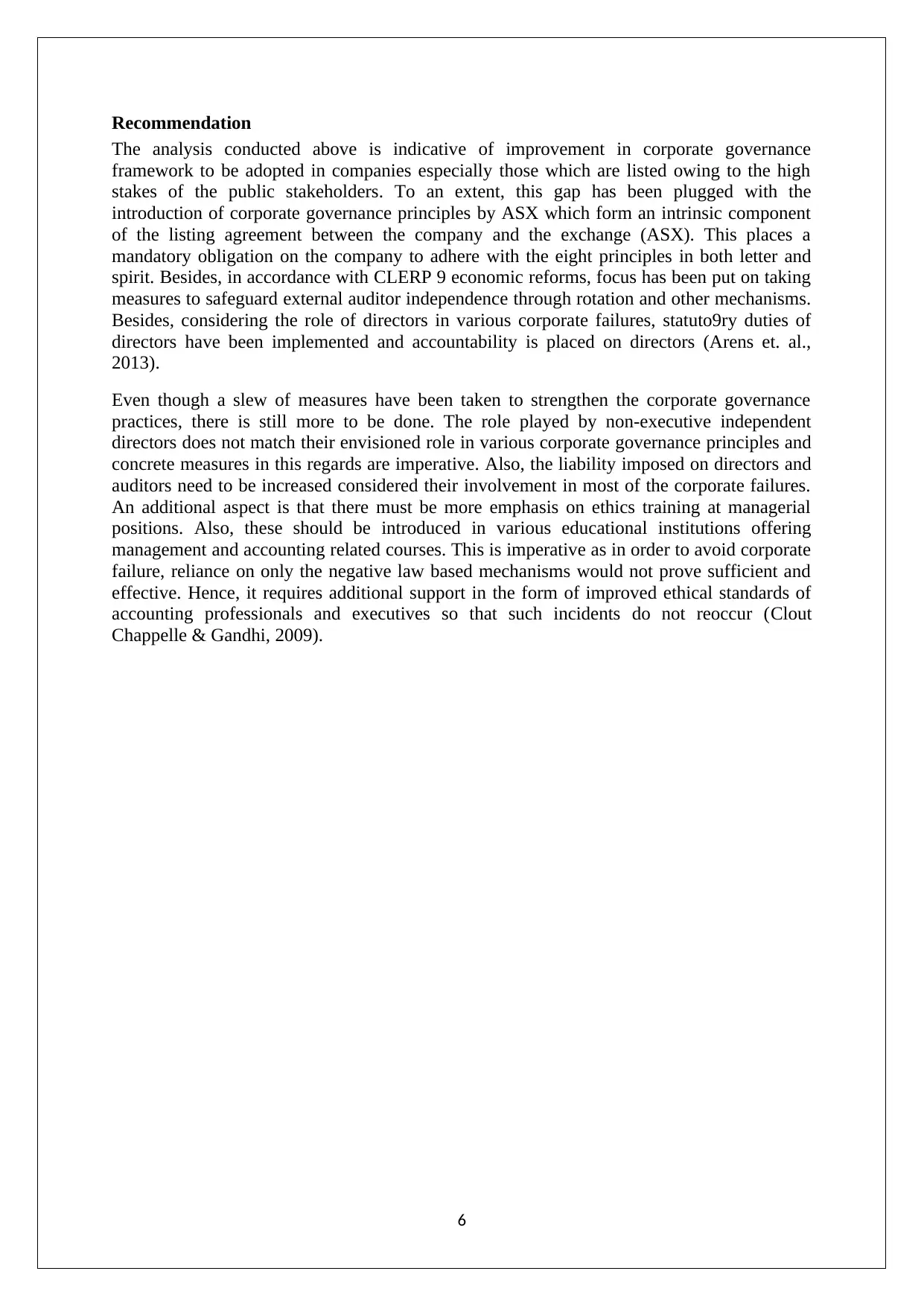
Recommendation
The analysis conducted above is indicative of improvement in corporate governance
framework to be adopted in companies especially those which are listed owing to the high
stakes of the public stakeholders. To an extent, this gap has been plugged with the
introduction of corporate governance principles by ASX which form an intrinsic component
of the listing agreement between the company and the exchange (ASX). This places a
mandatory obligation on the company to adhere with the eight principles in both letter and
spirit. Besides, in accordance with CLERP 9 economic reforms, focus has been put on taking
measures to safeguard external auditor independence through rotation and other mechanisms.
Besides, considering the role of directors in various corporate failures, statuto9ry duties of
directors have been implemented and accountability is placed on directors (Arens et. al.,
2013).
Even though a slew of measures have been taken to strengthen the corporate governance
practices, there is still more to be done. The role played by non-executive independent
directors does not match their envisioned role in various corporate governance principles and
concrete measures in this regards are imperative. Also, the liability imposed on directors and
auditors need to be increased considered their involvement in most of the corporate failures.
An additional aspect is that there must be more emphasis on ethics training at managerial
positions. Also, these should be introduced in various educational institutions offering
management and accounting related courses. This is imperative as in order to avoid corporate
failure, reliance on only the negative law based mechanisms would not prove sufficient and
effective. Hence, it requires additional support in the form of improved ethical standards of
accounting professionals and executives so that such incidents do not reoccur (Clout
Chappelle & Gandhi, 2009).
6
The analysis conducted above is indicative of improvement in corporate governance
framework to be adopted in companies especially those which are listed owing to the high
stakes of the public stakeholders. To an extent, this gap has been plugged with the
introduction of corporate governance principles by ASX which form an intrinsic component
of the listing agreement between the company and the exchange (ASX). This places a
mandatory obligation on the company to adhere with the eight principles in both letter and
spirit. Besides, in accordance with CLERP 9 economic reforms, focus has been put on taking
measures to safeguard external auditor independence through rotation and other mechanisms.
Besides, considering the role of directors in various corporate failures, statuto9ry duties of
directors have been implemented and accountability is placed on directors (Arens et. al.,
2013).
Even though a slew of measures have been taken to strengthen the corporate governance
practices, there is still more to be done. The role played by non-executive independent
directors does not match their envisioned role in various corporate governance principles and
concrete measures in this regards are imperative. Also, the liability imposed on directors and
auditors need to be increased considered their involvement in most of the corporate failures.
An additional aspect is that there must be more emphasis on ethics training at managerial
positions. Also, these should be introduced in various educational institutions offering
management and accounting related courses. This is imperative as in order to avoid corporate
failure, reliance on only the negative law based mechanisms would not prove sufficient and
effective. Hence, it requires additional support in the form of improved ethical standards of
accounting professionals and executives so that such incidents do not reoccur (Clout
Chappelle & Gandhi, 2009).
6
Paraphrase This Document
Need a fresh take? Get an instant paraphrase of this document with our AI Paraphraser
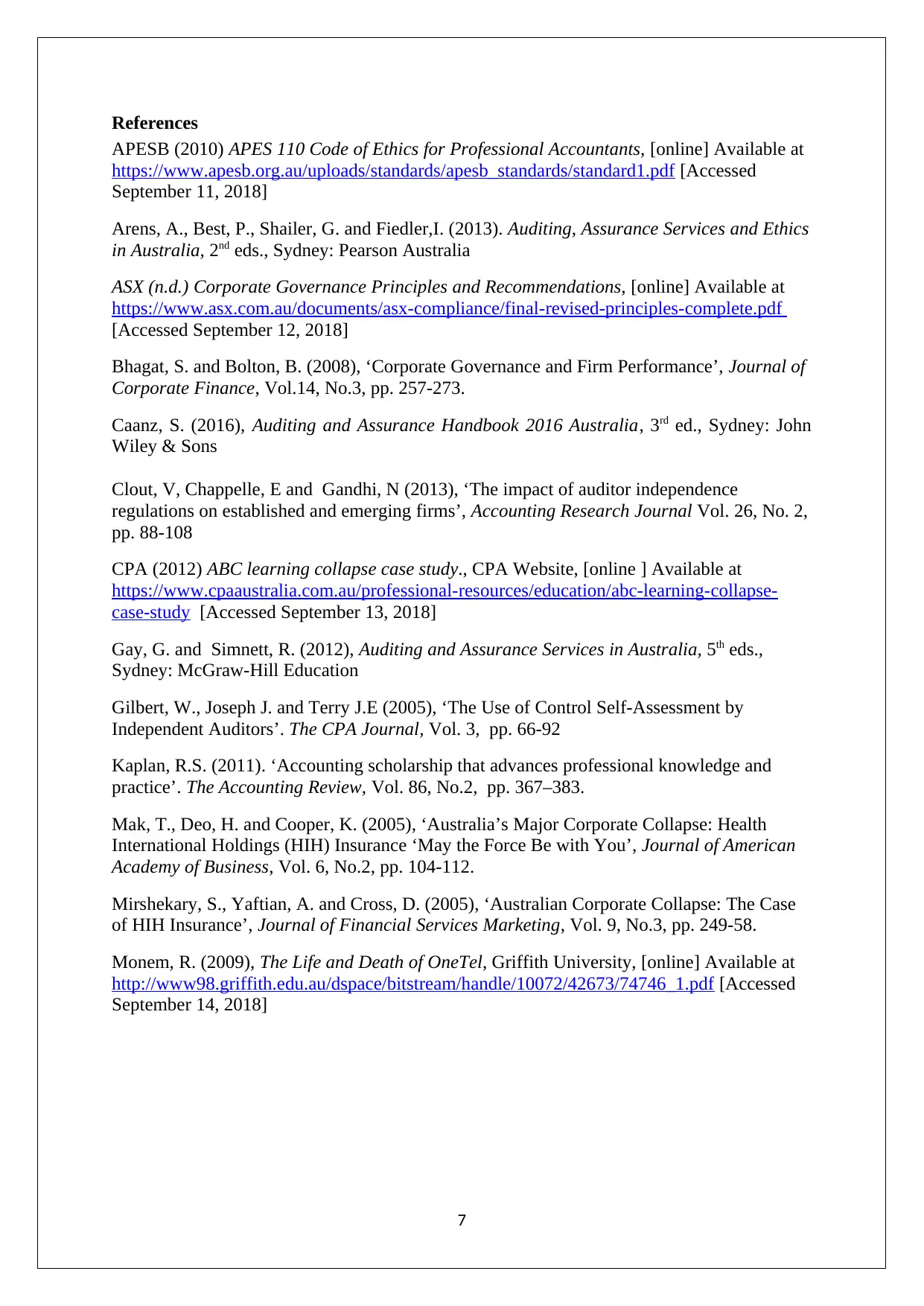
References
APESB (2010) APES 110 Code of Ethics for Professional Accountants, [online] Available at
https://www.apesb.org.au/uploads/standards/apesb_standards/standard1.pdf [Accessed
September 11, 2018]
Arens, A., Best, P., Shailer, G. and Fiedler,I. (2013). Auditing, Assurance Services and Ethics
in Australia, 2nd eds., Sydney: Pearson Australia
ASX (n.d.) Corporate Governance Principles and Recommendations, [online] Available at
https://www.asx.com.au/documents/asx-compliance/final-revised-principles-complete.pdf
[Accessed September 12, 2018]
Bhagat, S. and Bolton, B. (2008), ‘Corporate Governance and Firm Performance’, Journal of
Corporate Finance, Vol.14, No.3, pp. 257-273.
Caanz, S. (2016), Auditing and Assurance Handbook 2016 Australia, 3rd ed., Sydney: John
Wiley & Sons
Clout, V, Chappelle, E and Gandhi, N (2013), ‘The impact of auditor independence
regulations on established and emerging firms’, Accounting Research Journal Vol. 26, No. 2,
pp. 88-108
CPA (2012) ABC learning collapse case study., CPA Website, [online ] Available at
https://www.cpaaustralia.com.au/professional-resources/education/abc-learning-collapse-
case-study [Accessed September 13, 2018]
Gay, G. and Simnett, R. (2012), Auditing and Assurance Services in Australia, 5th eds.,
Sydney: McGraw-Hill Education
Gilbert, W., Joseph J. and Terry J.E (2005), ‘The Use of Control Self-Assessment by
Independent Auditors’. The CPA Journal, Vol. 3, pp. 66-92
Kaplan, R.S. (2011). ‘Accounting scholarship that advances professional knowledge and
practice’. The Accounting Review, Vol. 86, No.2, pp. 367–383.
Mak, T., Deo, H. and Cooper, K. (2005), ‘Australia’s Major Corporate Collapse: Health
International Holdings (HIH) Insurance ‘May the Force Be with You’, Journal of American
Academy of Business, Vol. 6, No.2, pp. 104-112.
Mirshekary, S., Yaftian, A. and Cross, D. (2005), ‘Australian Corporate Collapse: The Case
of HIH Insurance’, Journal of Financial Services Marketing, Vol. 9, No.3, pp. 249-58.
Monem, R. (2009), The Life and Death of OneTel, Griffith University, [online] Available at
http://www98.griffith.edu.au/dspace/bitstream/handle/10072/42673/74746_1.pdf [Accessed
September 14, 2018]
7
APESB (2010) APES 110 Code of Ethics for Professional Accountants, [online] Available at
https://www.apesb.org.au/uploads/standards/apesb_standards/standard1.pdf [Accessed
September 11, 2018]
Arens, A., Best, P., Shailer, G. and Fiedler,I. (2013). Auditing, Assurance Services and Ethics
in Australia, 2nd eds., Sydney: Pearson Australia
ASX (n.d.) Corporate Governance Principles and Recommendations, [online] Available at
https://www.asx.com.au/documents/asx-compliance/final-revised-principles-complete.pdf
[Accessed September 12, 2018]
Bhagat, S. and Bolton, B. (2008), ‘Corporate Governance and Firm Performance’, Journal of
Corporate Finance, Vol.14, No.3, pp. 257-273.
Caanz, S. (2016), Auditing and Assurance Handbook 2016 Australia, 3rd ed., Sydney: John
Wiley & Sons
Clout, V, Chappelle, E and Gandhi, N (2013), ‘The impact of auditor independence
regulations on established and emerging firms’, Accounting Research Journal Vol. 26, No. 2,
pp. 88-108
CPA (2012) ABC learning collapse case study., CPA Website, [online ] Available at
https://www.cpaaustralia.com.au/professional-resources/education/abc-learning-collapse-
case-study [Accessed September 13, 2018]
Gay, G. and Simnett, R. (2012), Auditing and Assurance Services in Australia, 5th eds.,
Sydney: McGraw-Hill Education
Gilbert, W., Joseph J. and Terry J.E (2005), ‘The Use of Control Self-Assessment by
Independent Auditors’. The CPA Journal, Vol. 3, pp. 66-92
Kaplan, R.S. (2011). ‘Accounting scholarship that advances professional knowledge and
practice’. The Accounting Review, Vol. 86, No.2, pp. 367–383.
Mak, T., Deo, H. and Cooper, K. (2005), ‘Australia’s Major Corporate Collapse: Health
International Holdings (HIH) Insurance ‘May the Force Be with You’, Journal of American
Academy of Business, Vol. 6, No.2, pp. 104-112.
Mirshekary, S., Yaftian, A. and Cross, D. (2005), ‘Australian Corporate Collapse: The Case
of HIH Insurance’, Journal of Financial Services Marketing, Vol. 9, No.3, pp. 249-58.
Monem, R. (2009), The Life and Death of OneTel, Griffith University, [online] Available at
http://www98.griffith.edu.au/dspace/bitstream/handle/10072/42673/74746_1.pdf [Accessed
September 14, 2018]
7
1 out of 8
Related Documents
Your All-in-One AI-Powered Toolkit for Academic Success.
+13062052269
info@desklib.com
Available 24*7 on WhatsApp / Email
![[object Object]](/_next/static/media/star-bottom.7253800d.svg)
Unlock your academic potential
© 2024 | Zucol Services PVT LTD | All rights reserved.





